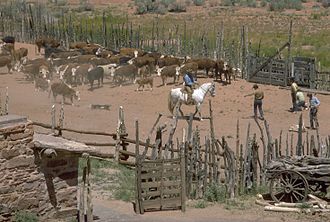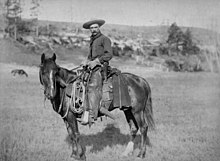Cowboy
![]()
Cowboys is a redirect to this article. For the film, see Cowboys (film). For other meanings of cowboy, see Cowboy (disambiguation).
![]()
This article or subsequent section is not sufficiently supported by evidence (e.g., anecdotal evidence). Information without sufficient evidence may be removed in the near future. Please help Wikipedia by researching the information and adding good supporting evidence.
A cowboy ['kaʊbɔɪ] (English literally: cowboy) is the term commonly used in North America for a cattle herder. In other regions of the New World they are called gauchos (Argentina, Paraguay, Uruguay), huasos (Chile), charros (Mexico), or vaqueiros (Brazil) or vaqueros (Venezuela). In Australia they are called stockmen.
The main era of cowboys began after 1865, when huge, feral herds of cattle had to be rounded up in Texas, and ended around 1880. As many as a third of the drovers were African Americans, who were free from slavery after a constitutional expansion in 1865, but without property or jobs. Likewise, there were cowboys of Mexican or Native American descent. There are still some cowboys in North America today. However, the way of working has changed a lot as a result of the industrialization of agriculture. However, modern ranchers and ranch employees also refer to themselves as cowboys and dress accordingly.

Cowboys at the Roundup, the gathering of the herds
Everyday life
The cowboy's profession was one of the hardest, especially in the 19th century, associated with hard work and hardships. A cowboy was often in the saddle ten hours a day with few breaks. On a cattle drive, all of life took place outdoors: People ate, slept, and tended to their needs outdoors. Often you didn't get out of your clothes for weeks, which also presented hygiene challenges.
There were many dangers for the cowboys on the routes: Indians, cattle rustlers or corrupt landowners who levied tariffs. The latter in particular escalated in the late 1870s when the "range wars" broke out in Texas and New Mexico. Herds were increasing in size at this time, but grazing land was becoming scarce. During this time, cowboys became involved in gunfights and skirmishes.
Trails also became longer and longer as herds were driven from the range directly to slaughterhouses or loading yards. Centers or transfer points at that time were Abilene, Hays and Dodge City in Kansas. When a trail was successfully completed, the cowboys were paid their wages and celebrated exuberantly in town. After weeks of privation, it was usually off to a bath house, clothes cleaned or better clothes brought along especially for the occasion. Then the evenings were spent in saloons or brothels, until it went again on the next trail.
An average herd of cattle consisted of 3000 head. At least ten cowboys with three horses each were needed to herd such a herd. The cowboys worked 24 hours a day in shifts. During the day they drove the herd in the desired direction, at night they guarded the herd to avoid stampedes and thefts.
The tasks of a cowboy were very diverse. Not only the driving of the cattle belonged to his tasks, he was also responsible for the marking of the cattle with brands as well as the health care of the animals (e.g. when calving). If the cowboys were on ranches, there was also a variety of work to do there, such as repairing the fences. Today, the above tasks are still an integral part of cowboy work. However, in modern ranching operations, quads are replacing horses more and more, though horses are still necessary for difficult terrain or certain cowboy work tasks.

Cowboy, South Dakota around 1888
Equipment and clothing
The cowboy's clothes are functional work clothes - originally they corresponded to the fashion of the 19th century. The trousers were coarse woolen trousers with leather inserts on the buttocks. The trousers went a little further up over the hips and were usually worn with suspenders. The shirts were at that time classically not yet buttoned through, but had to be pulled over the head. If necessary, a vest, the gilet, was worn over the shirt. Especially the dragriders, the cowboys riding at the end of the cattle herds, wore neckerchiefs, which they could pull over their noses against the swirling dust. For cold days, they wore wool jackets or coats. The cowboy hat was a very important part, it protected the rider from sun and rain. Further, one wore cowboy boots, which came in many different designs and styles.
The equipment consisted of the saddle, which was the most important working tool after the lasso. The boots were equipped with spurs. For defense one carried a revolver, a knife and a rifle. To protect themselves from thorny bushes, they wore leather leggings called chaps over their trousers. Further items of equipment were eating utensils and cutlery as well as a blanket.
To feed the cowboys on a long cattle drive, it was accompanied by a kitchen wagon called a chuckwagon. These were perfectly designed for carrying supplies and providing food for the workers. The team included a cook who drove the chuckwagon, which was usually pulled by oxen, and a wrangler who took care of the remuda, the spare horses. The cook was often not only responsible for the food, but also helped with minor injuries, butchered, sewed, mended, repaired and also acted as a barber.
Search within the encyclopedia